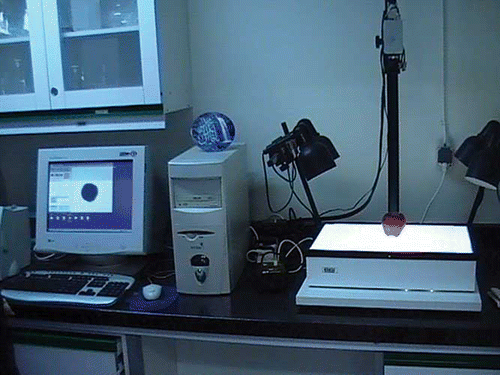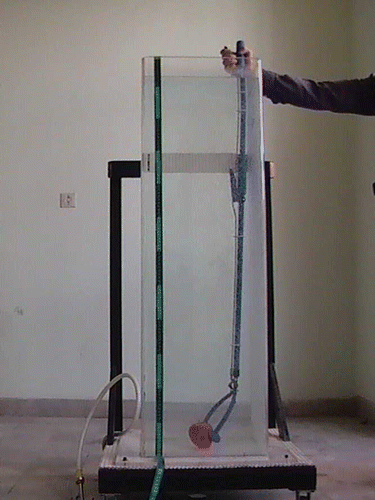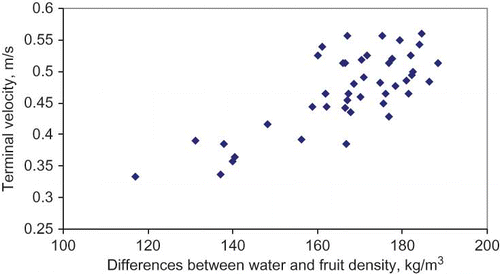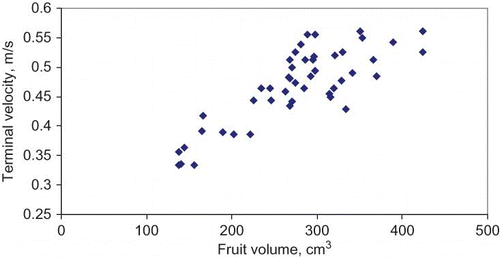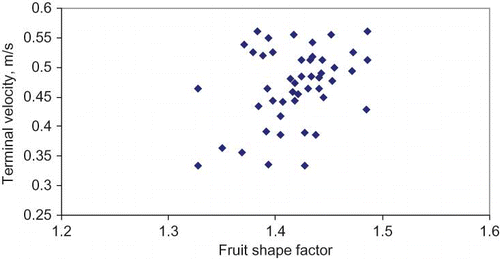Abstract
In this study, two theories for terminal velocity of fruits were proved by authors as KHAT1 and KHAT2 theories. Terminal velocity of Redspar apples was experimentally measured using water column and video camera. Some apple characteristics that affect on terminal velocity of apple based on proved theories were determined using standard methods. There is found that the most effective characteristics on apple terminal velocity were density and volume. The best equation for terminal velocity of Redspar apples was found with R2 = 0.69.
Keywords:
INTRODUCTION
Hydrodynamic properties are very important characters in hydraulic transport and handling as well as hydraulic sorting of agricultural products. To provide basic data for the development of equipment for sorting and sizing apples, several properties of apple such as: physical characteristics and terminal velocity are needed. Density, a good indicator of fruit dry matter,[Citation1,Citation2] thus becomes an interesting tool for fruit quality sorting because of its inherently lower cost and simpler operation. Density sorting of products is not new, and patents and publications in the potato industry extend from the 1950s to present day.[Citation3–5] Other products (e.g., citrus, blueberries, and tomatoes) have also been sorted by flotation techniques for quality or defects.[Citation6–8]
According to Jordan and Clerk[Citation9], an approach to fruit sorting is to use the terminal velocity of fruit moving in a fluid that has a density above or below the target density. Fruit with different terminal velocities will reach different depths after flowing a fixed distance in a flume. They reported that density-based sorting system based on these principles could be managed directly by pack house staff with little need for highly skilled advisors, as is the case with the alternative NIR approach.
Jordan and Clark,[Citation9] depicted trajectories of acceleration, velocity, and depth of a specific kiwifruit falling through water. They reported that kiwifruit was reached to its terminal velocity in slightly more than 0.5 s, and from there the depth trajectory follows a smooth linear path. They obtained following equation for terminal velocity of kiwi fruit drop in water:
The modeled dropping time for kiwifruits was: Td = Amb(ρf – ρt)c + D, considering constant value for drag coefficient (CD). In this equation m is fruit mass, (ρf − ρt) is differences between water and fruit densities, S is size factor of fruits, g is gravitational acceleration, A, b, c, and D are constant factors. The terminal velocity of apple in water column was determined. Its relationship with physical properties and possibly hydro-sorting of apple was investigated. In particular, fruit size and density over the random ranges expected for Redspar apple variety were investigated. In this study, only the terminal velocity of fruit rising from the bottom of a water column whose density is higher than that of the fruit was considered.
MATERIALS AND METHODS
Transport Equations
Consider a fruit of mass m, volume V, diameter d, and density ρf ( = m/V), rising in a liquid with density ρw (ρf < ρw) such that the largest cross-sectional area of fruit (A) is perpendicular to the direction of motion. The forces acting on it will be a gravitational force (Fw) downward, a buoyant force (Fb) upward, and a drag force (Fd) against the motion. The combination of these forces will accelerate the fruit at a rate (a) proportional to its mass:[Citation10]
where v is the fruit velocity. Dividing through by m = Vρf, gives:
where CD, drag coefficient, is a function of the velocity of the fruit and can be modeled well at low velocity using Stokes' law.[Citation10] Thus:
and
then
where NR is the dimensionless Reynolds number, μw is the static viscosity of the water, also a function of temperature,[Citation10] and d is the fruit diameter. Replacing in EquationEq. (2):
For a spherical object, A/V can be computed directly as a function of the diameter, but an apple is more hyper-ellipsoidal than spherical. According to Jordan and Clerk[Citation9], by separating A/V into two parts: a dimensionless shape factor (Sk), and a pure size (size) Thus:
And by knowing that
Then EquationEq. (6) becomes:
Where, e and k are constant factors. Values for the fruit volume, density, projected area and fruit shape were determined. When a particle falls through liquid at rest, its maximum rising velocity is reached when the apparent weight of the particle due to gravitational forces and drag forces equals the buoyancy. Then, setting acceleration to zero in EquationEq. (9), the terminal velocity (vt) of the fruit:
Terminal velocity proven theory for rising state in NR < 1 condition is a new theory developed by authors and named as KHAT 1 Theory. This equation shows that the terminal velocity is directly proportion to the difference between the fruit and water densities, with unit power, and volume, with a (2/3) power, and shape factor of fruits, with a (-1) power. From the above equations, it can be concluded that terminal velocity of fruits are more proportional to the difference between the fruit and water densities and shape factor than the volume of fruits. But Mohssenin[11Citation ], applied below formula for NR> 1:
using formula 4 in EquationEq. (11), yields:
Replacing EquationEq. (12) in EquationEq. (2); EquationEq. (13) will result:
and using formulas 7 and 8, EquationEq. (14) will result:
Setting acceleration to zero in EquationEq. (14), the terminal velocity of the fruit becomes as:
Assuming water density and viscosity as constant value, EquationEq. (16) will result as:
Terminal velocity proven theory for rising state in NR > 1 condition is a new theory developed by authors and named as KHAT 2 Theory. This theory shows that the terminal velocity of fruits is directly proportional to the difference between the fruit and water densities with power, volume with
power, and shape factor with
power, in NR > 1 condition.
Materials
Redspar apple cultivar, new-planted variety in Iran, was randomly hand-picked in summer season of 2007 from orchard located in Horticultural Research Center, Department faculty of agriculture, university of Tehran. This cultivar is also late season, red-color variety with large size and very sweet and delicious in taste. The 50 fruits were transferred to the laboratory in polyethylene bags to reduce water loss during transport. The initial moisture content of fruits was determined by using dry oven method.[Citation12] The remaining material was kept in cold storage in 4ºC until used. All of the experiments were carried out at a room temperature, in the Biophysical and Biological laboratories of university of Tehran, Karaj, Iran.
Physical Characteristics Determination
Volume and fruit density were determined by the water displacement method.[Citation11] Projected area of the apples was determined from pictures of the fruits taken by Area Measurement System-Delta Tengland, .
Terminal Velocity Determination
A glued Plexiglas column was constructed, height = 1200 mm and cross-section = 350 × 350 mm, shown in . This column was transparent, fruit diameter was approximately 20% of column diameter.[Citation13] The column was filled with tap water to a height of about 1100 mm. Each fruit was placed in the bottom of column using a nondestructive fruit holder, and any bubbles appearing on them were removed by rubbing. Fruit were then positioned flat (i.e., with their largest two dimensions oriented horizontally) in the bottom of column. To determine rising times and terminal velocities of fruits, a digital camera, JVC (770) with 25 frames per second, recorded the moving of fruits from releasing point to the top of water column, simultaneously. Each fruit was tested three or four times. Video to Frame software was used to change video film to images, subsequently to calculate coming up times and terminal velocities of fruits by knowing the fact that each picture takes 0.04 s.
Statistical Analysis
The information on the trajectory of fruit moving through the water was plotted in Microsoft Excel Worksheet. The effects of studied physical characteristics on terminal velocity were individually investigated using SPSS, 13, software. The coefficient of variation of characteristics was considered to compare the effectiveness of them, because of its unit dimension.
RESULTS AND DISCUSSION
Difference between the fruit and water densities, volume of fruits and fruit shape for Redspar apple were shown in . As apple rising from bottom of water column, the terminal velocity seemed to be reached almost immediately when observed by eye, and any wobbles of the fruit seemed small in amplitude. Most fruit showed little tendency to move and rotate significantly in horizontal directions.
Table 1 Difference between the fruit and water densities, volume with (2/3) power and shape with (-1) power for Redspar apples
shows the computed trajectories of acceleration, velocity, and depth for an apple at a fruit density of 816.10 kg/m3 and volume of 388.8 cm3 rising through water column from the images. Terminal velocity (0.542 m/s) is reached in slightly more than 0.5 s. Terminal velocities of apples were plotted against the difference between the fruit and water densities (ρw−ρf), volume of fruits and fruit shape in , , and . with more regular plots than that of showed the higher effectiveness of volume than that of differences between water and fruit densities on terminal velocity of apples. Irregular plots in depicted the low effectiveness of shape factor on terminal velocity of apples. As resulted 4066 as the mean value of Reynolds Number for Redspar apples (NR > 1), the following model was derived from EquationEq. (16) (KHAT 2 theory) for modeling terminal velocity of apples:
Figure 3 Acceleration (m), velocity (d), and depth (j) of fruit rising in water. Fruit density was set to 816.10 kg/m3 and volume to 388.8 cm3.
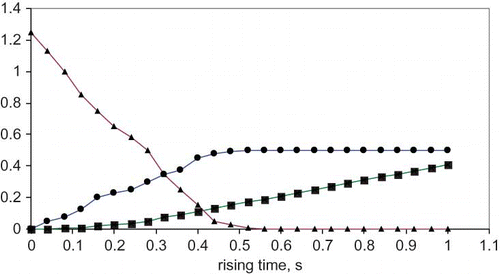
In order to find the most effective parameter on terminal velocity of Redspar apple, the terminal velocity with above characteristics was individually modeled as follow:
From the EquationEqs. (18)–(Equation20), it can be inferred that terminal velocity of fruits is more proportional to the volume of fruits (R2 = 0.68) as well as differences between the water and fruit densities (R2 = 0.58) than shape factor of Redspar apple (R2 = 0.04). This result may be due to the fact that the coefficient of variation of Redspar apple volume (CV = 0.25) and that of differences between water and fruit density (CV = 0.10) is more than that of shape factor of Redspar apple (0.02). As seen in , with increase in terminal velocity, the variation of shape factor is low, such that can be assumed as constant coefficient. Above results show that the most effective characters of Redspar apple on its terminal velocity are volume and density because their variations were considerable. By comparing between EquationEqs. (18) and (Equation19) it inferred that volume of fruits is more effective than differences between the water and fruit densities. Effectiveness of all parameters was studied in EquationEq. (20). The coefficient of determination (R2) of this equation was found as 0.72.
A little more positive power of volume than that of differences between water and fruit densities in model above showed more effectiveness of volume than that of differences between the water and fruit densities on terminal velocity of apples emphasized by EquationEqs. (18) and Equation(19) and also by and .
By subtracting effectiveness of shape factor of apples on their terminal velocity in EquationEq. (21), there is no significant reduction in R2. This fact depicted low effectiveness of shape factor on terminal velocity of apples, emphasized by EquationEqs. (20) and also by .
One can conclude from this research that apple fruits with approximately constant volume can be sorted based on their densities. Jordan and Clark[Citation9] reported that the time taken for kiwi fruit to drop a fixed distance in water is a simple function of the square root of the difference between the fruit density and the density of the fluid in which it falls and the fruit mass has a negligible effect on the results and can be ignored. They found an equation for dropping time of kiwi fruit as:
In EquationEq. (22), terminal velocity was modeled as function of volume, differences between fruit and water density and shape factor of fruits but Jordan and Clark modeled the dropping time of kiwi fruit as function of mass and differences between fruit and water density. Another difference between EquationEqs. (22) and (Equation23) is shape factor. In this study, terminal velocity of apples was modeled based on Jordan and Clark, 2004, equation as:
In EquationEq. (24), R2 = 0.63 that is lower than that of EquationEq. (21) (R2 = 0.72). This fact was happened because of considering volume instead of fruits mass and shape factor in KHAT 2 theory and then EquationEq. (21), and approves the validation of EquationEq. (21) and then KHAT 2 theory.
CONCLUSION
In this study, terminal velocity of Redspar apple and the effective factors on that, such as; density, volume and shape factor were investigated. The coefficients of variation of differences between water and fruit density, volume and apple shape factor were respectively found as 0.096, 0.172, and 0.024. Since the range of variation of shape factor of apple was small, (e.g., shape factor of apples was approximately constant) the most effective characteristics on terminal velocity were density and volume. The best equation to model terminal velocity of Redspar apples was found as;
One can conclude from this research that apple fruits with approximately constant volume can be sorted based on their densities.
ACKNOWLEDGMENTS
The authors would like to thank University of Tehran for full support and Horticultural Research Center, Department, Faculty of Agriculture, university of Tehran Karaj, Iran for providing the fruits for this project. Special thanks to Mr. Usoflu, Dr. Delshad, Eng. Sepahvand, and Eng. Rahimi for their help.
REFERENCES
- Jordan , R.B. , Walton , E.F. , Klages , K.U. and Seelye , R.J. 2000 . Postharvest fruit density as an indicator of dry matter and ripened soluble solids of kiwifruit. Postharvest Biol . Tech , 20 ( 2 ) : 163 – 173 .
- Richardson , A.C. , McAneney , K.J. and Dawson , E. T. 1997 . Carbohydrate dynamics in kiwifruit. J . Hort. Sci , 72 ( 5 ) : 907 – 917 .
- Bajema , R.W. 2001 . System for debris elimination and item separation and method of use thereof . U.S. Patent, No. 6293407 ,
- Kunkel , R. , Gifford , P.F. , Edgar , E.D. and Binkley , M. A. 1952 . The mechanical separation of potatoes into specific gravity groups , Bulletin 422-A Fort Collins, CO : Colorado Agricultural and Mechanical College .
- Wilson , J.H. and Lindsay , M. A. 1969 . The relation between specific gravity and dry matter content of potato tubers . American Potato J , 46 ( 9 ) : 323 – 328 .
- Gutterman , R.P. 1976 . “ Mass flow density sorter for fruit and vegetables ” . In Quality Detection in Foods , Edited by: Gaffney , J. J. 211 – 213 . St. Joseph, MI : Comp.; ASAE publication .
- Patzlaff , A.W. 1980 . Hydrodynamic blueberry sorting . U.S. Patent, No. 4225424 ,
- Perry , R.L. and Perkins , R.M. 1968 . Separators for frost damaged oranges . Citrograph , 53 ( 8 ) : 304 – 312 .
- Jordan , R.B. and Clark , C.J. 2004 . Sorting of kiwifruit for quality using drop velocity in water . ASAE , 47 ( 6 ) : 1991 – 1998 .
- Crowe , C.T. , Elger , D.F. and Roberson , A. J. 2001 . Engineering Fluid Dynamics , 7th , New York, N.Y : John Wiley and Sons .
- Mohsenin , N.N. 1986 . Physical Properties of Plant and Animal Materials , 2nd , New York : Gordon and Breach Science Publishers .
- Yagcoglu , A. 1999 . Drying techniques of agricultural products. Ege university, Agricultural Faculty , Publication number: 536 Bornova, Izmir, , Turkey : Ege University .
- Vanoni , V.A. 1975 . Sedimentation Engineering , ASCE Manual 54 New York : ASCE .
- Rajabipour , A. , Tabatabaeefar , A. and Farahani , M. 2006 . Effect of Moisture on Terminal Velocity of Wheat Varieties . Int. J. Agric. Biol. , 8 ( 1 ) : 10 – 13 .
